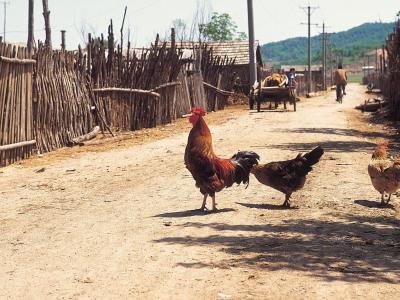Mar 30, 2011
Thai researchers find hybrid of 2009 H1N1 and swine virus in pigs
Researchers from Bangkok say pigs in Thailand were infected with a novel influenza virus that combined genes from the human 2009 H1N1 virus with the neuraminidase gene from a Thai swine H1N1 virus. The reassorted H1N1 virus was found in nursery pigs during a respiratory disease outbreak in central Thailand in early 2010, according to the researchers' report in Virus Genes. The virus was discovered within months after the pandemic 2009 virus spread into the Thai swine population late in 2009. The novel virus was isolated from infected pigs repeatedly, suggesting that it can spread efficiently in pig populations. "The finding highlights the role of pig[s] in generating newly reassorted influenza A viruses and also the significance of continuing disease surveillance and genetic characterization of SIV [swine influenza virus] in pigs," the report says.
Mar 26 Virus Genes abstract
H7N3 found on Missouri turkey farm
Routine pre-slaughter testing has identified H7N3 avian influenza at a commercial turkey farm in Missouri, according to a report today to the World Organization for Animal Health (OIE). Located in Polk County, the turkey operation had 14,000 19-week-old turkeys in one barn and 16,000 5-week-old birds in another. Testing was conducted as part of the National Poultry Improvement Plan's Avian Influenza Clean Program. The birds did now show any signs of disease. An investigation has not found the source of the virus. The findings prompted Missouri to implement its H5/H7 response and containment plan, including a quarantine of the farm, but the report did not mention culling. Polk County is in south-central Missouri, not far from Springfield. The United States' last low-pathogenic avian influenza outbreak occurred in August 2009, when the H7N9 virus turned up on a turkey farm in Meeker County, Minnesota, according to previous OIE reports.
Mar 30 OIE report
Vietnam, Bangladesh report H5N1 outbreaks
In a report to the OIE, Vietnam's agriculture ministry today described eight H5N1 avian influenza outbreaks that occurred during the first part of March. Outbreaks occurred in six provinces, mainly in northern and central Vietnam. All but one of them were in villages. In total, the outbreaks killed 5,147 birds, and 6,140 more were culled to stop the virus from spreading. In Bangladesh, officials reported two more H5N1 outbreaks, which occurred at poultry farms in two different cities in Rangpur division's Dinajpur district in the northwestern part of the country, the Daily Star, a Dhaka-based newspaper, reported today. Outbreak response operations included the culling of 7,866 birds and destruction of 512 eggs.
Mar 30 OIE report
Mar 30 Daily Star story
Study finds vaccination rates higher in households with elderly, very young
A pre-pandemic telephone survey found that households in the Minneapolis-St Paul area with more than one person had a complete-household seasonal influenza vaccination rate of 35% and a 40% partial-household vaccination rate, but that rates were higher in households with an elderly resident or a child 5 years old or younger. In early 2009 researchers surveyed 800 household in the Twin Cities area and found an overall individual vaccination rate of 52%. They found that 51% of households with children 1 year old or older had all children vaccinated, but 44% of households with children had none of the children vaccinated. The overall rate of complete household nonvaccination in multi-person homes was 25%, but it dropped to10% in households with an elderly person or young child. For households containing an elderly member, full and partial household vaccination rates were 69% and 21%, respectively, while in households with a child age 5 or under they were both 46%. The authors say they believe theirs is the first study of household flu vaccination patterns. It was funded by a grant from the Minnesota Vikings as part of their "Tackling Influenza" program, which promotes vaccination for underserved and high-risk children in the Twin Cities.
Mar 29 Vaccine abstract
Researchers find myositis link to influenza B in German kids
German researchers have linked a rare muscle condition in children to an influenza B outbreak in 2007-08 in that country. Writing in The Pediatric Infectious Disease Journal, they report on 219 children (median age, 7 years; 74% male) with influenza-associated benign acute childhood myositis (BACM) that "coincided with the curve of influenza B of the German virologic sentinel surveillance system for influenza." Patients experienced the onset of BACM symptoms shortly after the onset of influenza symptoms. And although almost half the patients sought hospital care, the disease course was "almost exclusively mild and self-limiting," according to the study. The researchers reported one patient who had early-stage renal impairment but who recovered quickly. Multivariable analysis revealed that BACM was strongly associated with influenza B, male sex, and age between 6 and 9 years. The authors conclude, "Diagnosis of this rare but distinct clinical entity by the alert physician can spare the patient potentially unneeded invasive testing and hospital admission."
Mar 28 Ped Infect Dis J abstract


















